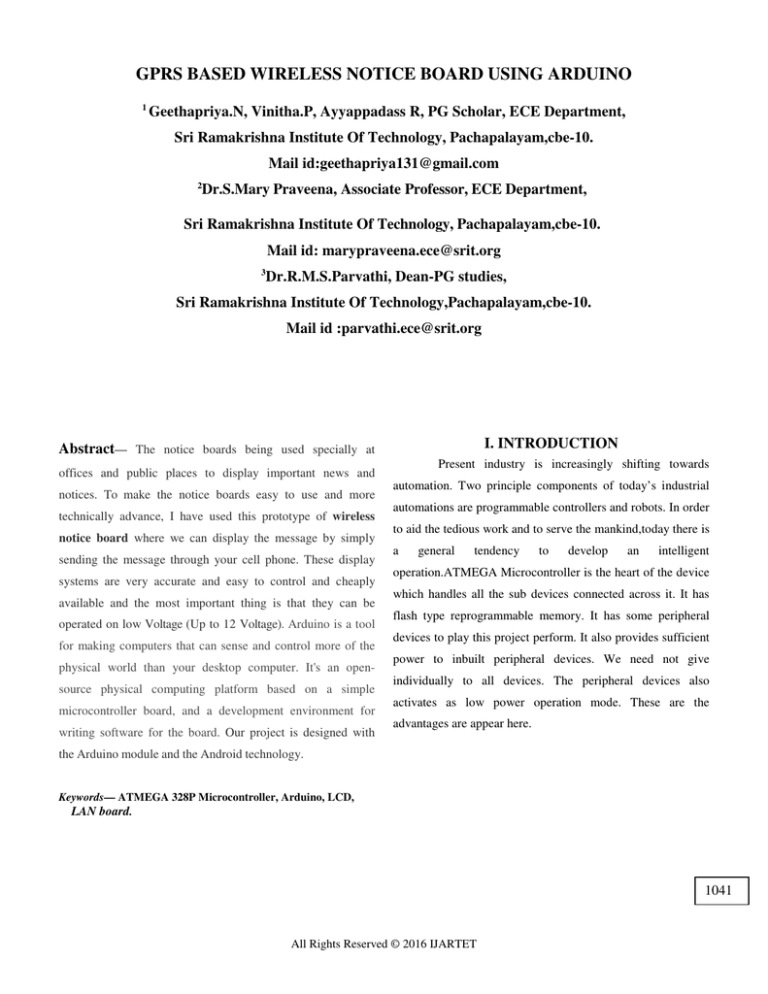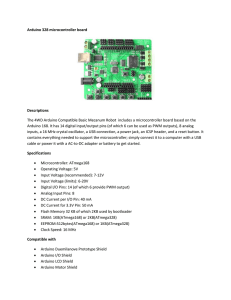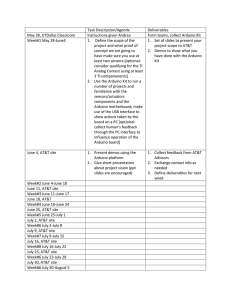
GPRS BASED WIRELESS NOTICE BOARD USING ARDUINO
1
Geethapriya.N, Vinitha.P, Ayyappadass R, PG Scholar, ECE Department,
Sri Ramakrishna Institute Of Technology, Pachapalayam,cbe-10.
Mail id:geethapriya131@gmail.com
2
Dr.S.Mary Praveena, Associate Professor, ECE Department,
Sri Ramakrishna Institute Of Technology, Pachapalayam,cbe-10.
Mail id: marypraveena.ece@srit.org
3
Dr.R.M.S.Parvathi, Dean-PG studies,
Sri Ramakrishna Institute Of Technology,Pachapalayam,cbe-10.
Mail id :parvathi.ece@srit.org
I. INTRODUCTION
Abstract— The notice boards being used specially at
Present industry is increasingly shifting towards
offices and public places to display important news and
notices. To make the notice boards easy to use and more
technically advance, I have used this prototype of wireless
notice board where we can display the message by simply
sending the message through your cell phone. These display
systems are very accurate and easy to control and cheaply
available and the most important thing is that they can be
operated on low Voltage (Up to 12 Voltage). Arduino is a tool
for making computers that can sense and control more of the
physical world than your desktop computer. It's an opensource physical computing platform based on a simple
microcontroller board, and a development environment for
writing software for the board. Our project is designed with
automation. Two principle components of today’s industrial
automations are programmable controllers and robots. In order
to aid the tedious work and to serve the mankind,today there is
a
general
tendency
to
develop
an
intelligent
operation.ATMEGA Microcontroller is the heart of the device
which handles all the sub devices connected across it. It has
flash type reprogrammable memory. It has some peripheral
devices to play this project perform. It also provides sufficient
power to inbuilt peripheral devices. We need not give
individually to all devices. The peripheral devices also
activates as low power operation mode. These are the
advantages are appear here.
the Arduino module and the Android technology.
Keywords— ATMEGA 328P Microcontroller, Arduino, LCD,
LAN board.
1041
All Rights Reserved © 2016 IJARTET
1.0 pinout: added SDA and SCL pins that are near to the
AREF pin and two other new pins placed near to the RESET
pin, the IOREF that allow the shields to adapt to the voltage
provided from the board. In future, shields will be compatible
with both the board that uses the AVR, which operates with 5V
and with the Arduino Due that operates with 3.3V. The second
one is a not connected pin, that is reserved for future purposes.
Stronger RESET circuit. Atmega 16U2 replace the 8U2.
"Uno" means one in Italian and is named to mark the
upcoming release of Arduino 1.0. The Uno and version 1.0
Figure1. Block Diagram Description
will be the reference versions of Arduino,moving forward. The
Uno is the latest in a series of USB Arduino boards, and
the reference model for the Arduino platform.
1.1.ARDUINO UNO
Physical Characteristics:
The maximum length and width of the Uno PCB are 2.7 and
2.1 inches respectively, with the USB connector and power
jack extending beyond the former dimension. Four screw
holes allow the board to be attached to a surface or case. Note
that the distance between digital pins 7 and 8 is 160 mil
(0.16"), not an even multiple of the 100 mil spacing of the
other pins.
Applications of Arduino:
Xoscillo: open-source oscilloscope.
Scientific equipment .
The Arduino Uno is a microcontroller board based on
the ATmega328(datasheet). It has 14 digital input/output pins
Arduinome: a MIDI controller device that mimics the
monomer
(of which 6 can be used as PWM outputs), 6 analog inputs, a
Ardupilot: drone software/hardware
16 MHz ceramic resonator, a USB connection, a power jack,
Arduino phone
an ICSP header, and a reset button. It contains everything
Water quality testing platform
needed to support the microcontroller; simply connect it to a
computer with a USB cable or power it with a AC-to-DC
1. 2.ATMEGA 328P MICRO CONTROLLER
The ATmega 48PA/88PA/168PA/328P is a low-
adapter or battery to get started.
The Uno differs from all preceding boards in that it does not
power CMOS 8-bit microcontroller based on the AVR
use the FTDI USB to-serial driver chip. Instead, it features the
enhanced
Atmega 16U2(Atmega8U2 up to version R2) programmed as
instructions
a USB-to-serial converter. Revision 2 of the Uno board has a
ATmega48PA/88PA/168PA/328P
resistor pulling the 8U2 HWB line to ground, making it easier
approaching 1 MIPS per MHz allowing the system designed to
to put into DFU mode.
optimize power consumption versus processing speed The
Revision 3 of the board has the following new features:
ATmega48PA/88PA/168PA/328P provides the following
RISC
in
architecture.
a
single
By
executing
clock
achieves
powerful
cycle,
the
throughputs
features: 4K/8K bytes of In-System Programmable Flash with
All Rights Reserved © 2016 IJARTET
Read-While-Write
capabilities,
256/512/512/1K
bytes program in the Application Flash memory. By combining an 8-
EEPROM, 512/1K/1K/2K bytes SRAM, 23 general purpose I/O bit RISC CPU with In-System Self-Programmable Flash on a
lines, 32 general purpose working registers, three flexible monolithic chip, the Atmel ATmega48PA/88PA/168PA/328P is a
Timer/Counters with compare modes, internal and external powerful microcontroller that provides a highly flexible and cost
interrupts, a serial programmable USART, a byte-oriented 2- effective solution to many embedded control applications. The
wire Serial Interface, an SPI serial port, a 6-channel 10-bit Boot program can use any interface to download the application
Christo Ananth et al. [5] discussed about Intelligent Sensor program in the Application Flash memory. This allows very fast
Network for Vehicle Maintenance System. Modern automobiles start-up combined with low power consumption.
are no longer mere mechanical devices; they are pervasively
Even though there are separate addressing
monitored through various sensor networks & using integrated
schemes and optimized opcodes for register file and I/O
circuits and microprocessor based design and control techniques
register access, all can still be addressed and manipulated as if
while this transformation has driven major advancements in
they were in SRAM. In the ATMEGA variant, the working
efficiency and safety. In the existing system the stress was
register file is not mapped into the data address space; as such,
given on the safety of the vehicle, modification in the physical
it is not possible to treat any of the ATMEGA's working
structure of the vehicle but the proposed system introduces
registers as though they were SRAM. Instead, the I/O registers
essential concept in the field of automobile industry. It is an
are mapped into the data address space starting at the very
interfacing of the advanced technologies like Embedded
beginning of the address space. Additionally, the amount of
Systems and the Automobile world. This “Intelligent Sensor
data address space dedicated to I/O registers has grown
Network for Vehicle Maintenance System” is best suitable for
substantially to 4096 bytes (000016–0FFF16). As with
vehicle security as well as for vehicle’s maintenance. Further it
previous generations, however, the fast I/O manipulation
also supports advanced feature of GSM module interfacing.
instructions can only reach the first 64 I/O register locations
Through this concept in case of any emergency or accident the
(the first 32 locations for bitwise instructions). In most
system will automatically sense and records the different
variants of the AVR architecture, this internal EEPROM
parameters like LPG gas level, Engine Temperature, present
memory is not mapped into the MCU's addressable memory
speed and etc. so that at the time of investigation this
space. It can only be accessed the same way an external
parameters may play important role to find out the possible
peripheral device is, using special pointer registers and
reasons of the accident. Further, in case of accident & in case of
read/write instructions which makes EEPROM access much
stealing of vehicle GSM module will send SMS to the Police,
slower than other internal RAM.
insurance company as well as to the family members.
The Idle Mode stops the CPU while allowing the RAM,
ETHERNET BOARD FOR LAN
timer/counters, serial port, and interrupt system to continue
The Arduino Ethernet Shield connects your Arduino to
functioning. The Power-down mode saves the RAM contents
the internet in mere minutes. Just plug this module onto your
but freezes the oscillator, disabling all other chip functions until
Arduino board, connect it to your network with an RJ45 cable
the next interrupt or hardware reset. The device is manufactured
(not included) and follow a few simple instructions to start
using Atmel’s high density non-volatile memory technology.
controlling your world through the internet. As always with
The On-chip ISP Flash allows the program memory to be
Arduino, every element of the platform – hardware, software
reprogrammed In-System through an SPI serial interface, by a
and documentation – is freely available and open-source. This
conventional non-volatile memory programmer, or by an On-
means you can learn exactly how it's made and use its design
chip Boot program running on the AVR core. The Boot
program can use any interface to download the application
as the starting point for your own circuits. Hundreds of
The shield also includes a reset controller, to ensure
thousands of Arduino boards are already fuelling people’s
that the W5100 Ethernet module is properly reset on power-
creativity all over the world, everyday.
up. Previous revisions of the shield were not compatible with
the Mega and need to be manually reset after power-up.The
current shield has a Power over Ethernet (PoE) module
• Requires an Arduino board (not included)
designed to extract power from a conventional twisted pair
• Operating voltage 5V (supplied from the Arduino
Category 5 Ethernet cable:
Board)
• Connection speed: 10/100Mb
•
•
•
•
•
•
IEEE802.3af compliant
Low output ripple and noise (100mVpp)
Input voltage range 36V to 57V
Overload and short-circuit protection
9V Output
High efficiency DC/DC converter: type 75% @ 50%
• Connection with Arduino on SPI port
•
load
1500V isolation (input to output)
• Ethernet Controller: W5100 with internal 16K
buffer
The Arduino Ethernet Shield allows an Arduino
The shield does not come with the PoE module
board to connect to the internet. It is based on the Wiznet
buildin; it is a s eparate component that must be added on.
W5100ethernet chip (datasheet). The Wiznet W5100 provides
Arduino communicates with both the W5100 and SD card
a network (IP) stack capable of both TCP and UDP. It supports
using the SPI bus (through the ICSP header). This is on digital
up to four simultaneous socket connections. Use the Ethernet
pins 10, 11, 12, and 13 on the Uno and pins 50, 51, and 52 on
library to write sketches which connect to the internet using
the Mega. On both boards, pin 10 is used to select the W5100
the shield. The Ethernet shield connects to an Arduino board
and pin 4 for the SD card. These pins cannot be used for
using long wire-wrap headers which extend through the shield.
general I/O. On the Mega, the hardware SS pin, 53, is not used
This keeps the pin layout intact and allows another shield to be
to select either the W5100 or the SD card, but it must be kept
stacked on top.
as an output or the SPI interface won't work.
The most recent revision of the board exposes the 1.0
Note that because the W5100 and SD card share the
pin out on rev 3 of the Arduino UNO board.The Ethernet
SPI bus, only one can be active at a time. If you are using both
Shield has a standard RJ-45 connection, with an integrated
peripherals in your program, this should be taken care of by
line transformer and Power over Ethernet enabled. There is an
the corresponding libraries. If you're not using one of the
onboard micro-SD card slot, which can be used to store files
peripherals in your program, however, you'll need to explicitly
for serving over the network. It is compatible with the Arduino
deselect it. To do this with the SD card, set pin 4 as an output
Uno
The
and write a high to it. For the W5100, set digital pin 10 as a
onboardmicroSD card reader is accessible through the SD
high output.The shield provides a standard RJ45 Ethernet
Library. When working with this library, SS is on Pin 4. The
jack.The reset button on the shield resets both the W5100 and
original revision of the shield contained a full-size SD card
the Arduino board. The shield contains a number of
slot; this is not supported.
informational LEDs:
and
Mega
(using
the
Ethernet
library).
PWR: indicates that the board and shield are powered.
LINK: indicates the presence of a network link and
flashes when the shield transmits or receives data
display information written or printed on Papers, pinned to a
notice board.
FULLD: indicates that the network connection is full
duplex
100M: indicates the presence of a 100 Mb/s network
connection (as opposed to 10 Mb/s)
RX: flashes when the shield receives data
TX: flashes when the shield sends data
COLL: flashes when network collisions are detected
The solder jumper marked "INT" can be connected to
allow
the
Arduino
board
to
receive
interrupt-driven
notification of events from the W5100, but this is not
supported by the Ethernet library. The jumper connects the
INT pin of the W5100 to digital pin 2 of the Arduino.
Fig 2.
LCD DISPLAY
This involved man power, i.e., manually changing
Liquid crystal displays (LCDs) have materials which
combine the properties of both liquids and crystals. An LCD
consists of two glass panels, with the liquid crystal material
sand witched in between them. The inner surface of the glass
plates are coated with transparent electrodes which define the
information every time in order for the information to be
updated and sometimes there is also delay in updating the
information. But as the technology in the embedded field
developed, there have been various improvisations in the types
of notice boards and the way of updating information in them.
character, symbols or patterns to be displayed polymeric
layers are present in between the electrodes and the liquid
crystal, which makes the liquid crystal molecules to maintain a
defined orientation angle.
The main aim of this project is to design an GPRS
driven automatic display. Notice board is a primary device in
any institution/organization or public utility places like bus
stations, railway stations and parks. So the proposal is used to
design a notice board using Arduino such that it can fulfil the
III. OPERATION OF GPRS BASED
requirements such as less manual operation, same notice board
WIRELESS NOTICE BOARD USING
can be displayed in various places at the same time, he notice
ARDUINO
board display should be visible from maximum area or
distance, compact compatible and easy handling .The message
WIRELESS NOTICE BOARD USING ARDUINO:
The world is going mobile phones and each person
wants to control everything without moving an inch. For the
past few years, the general idea of a notice board has been
to
to be displayed is sent through SMS to a GPRS modem using
Arduino and the message will be displayed on LCD display.
IV. CONSTRUCTION OF GPRS
BASED WIRELESS NOTICE BOARD
USING ARDUINO
Fig.4.Android app
Fig 3.
The proposed design is a receiver come display board which
Fig.5. RESULT
can be programmed from an authorized mobile phone. The
message to be displayed is sent as an SMS from an authorized
transmitter. The Arduino receives and reads the SMS, validates
the sending message and displays the desired information on
in the LCD display. Looking into current trend of information
transfer in the campus, it is seen that important notice takes
time to be displayed in the notice board using GPRS modem`
interfaced with Arduino. This latency is not expected in most
The main components required for the purpose include an
Arduino, GPRS modem and LCD display. The GPRS modem
receives the SMS from an authorized user.The modem
transmits the stored message through the COM port to the PC.
The message stored in PC and it reads the message with the
help of Arduino. The Arduino validates the SMS and then
displays the message in the LCD display board.
of the cases and must avoided.The below app is used to upload
data in the notice board.Once data is typed datas are displayed
TABLE 1
in tha notice board.
VARIOUS PARAMETER MEASUREMENT
S.N
O
1.
Parameters
Range
Microcontroller ATmega328
Operating Voltage
5V
7-12V
Input Voltage (recommended)
Input Voltage (limits)
6-20V
2.
Digital I/O Pins 14 (of which 6
to be designed for some of the examples are as follows to
provide PWM output)
Manage Traffic Metropolitan cities are prone to high traffic
DC Current per I/O Pin
DC Current for 3.3V Pin
congestion. One way to avoid this would be to inform people
40 mA
50 mA
beforehand to take alternate routes. A wireless notice board
using arduino serves well for this support. Crime Prevention
3.
4.
5.
6.
Flash Memory
SRAM
EEPROM
Clock Speed
32 KB
2 KB
1 KB
16 MHz
7.
Length
68.6 mm
8.
Weight
25 g
9.
Width
53.4 mm
Display boards can be put on roads to display tips on public
security, accident prevention, and information on criminals on
the run and also to flash messages regarding vehicle thefts as
and when they occur. This project can be implemented in
offices, colleges, schooles etc…
REFERENCES
Advantages:
•
•
•
•
Low power consumption
More flexible
Smaller in size
Easy to handle
V.CONCLUSION
The progress in science and technology is a nonstopping process. New things and new technology are being
invented. As the technology grows day by day we can imagine
about the future in which thing that may occupy every place.
The proposed system based on ATMEGA microcontroller is
found to be more compact, user friendly and less complex
which can readily be used in order to perform. Several tedious
and repetitive tasks. Though it is designed keeping in mind
about the need for industry, it can extended for other purposes
[1] Pawn Kumar, VikasBhrdwaj, Kiran Pal, Narayan Singh
Rathor, Amit Mishra,“GSM based e-Notice Board” ,
International Journal of Soft Computing and Engineering
(IJSCE) ISSN.
[2] Foram Kamdar , Anubbhav Malhotra and Pritish
Mahadik”Advance in Electronic and Electric Engineering.
“ISSN 2231-1297, Volume 3, Number 7 (2013), pp. 827-832
[3] International Journal Of Engineering And Computer
Science ISSN:2319-7242 Volume 2 Issue 4 April, 2013 Page
No. 1035 -1041” Multiuser Short Message Service Based
Wireless Electronic Notice Board “.
[4] National conference on recent trends in engineering
technology “wireless notice board our real-time solution” May
2011.
[5] Christo Ananth, C.Sudalai@UtchiMahali, N.Ebenesar
Jebadurai, S.Sankari@Saranya, T.Archana, “Intelligent sensor
Network for Vehicle Maintenance system”, International
Journal of Emerging Trends in Engineering and Development
(IJETED), Vol.3, Issue 4, May 2014, pp-361-369
[6] Agamanolis.S, “Digital displays for human connect
endless”. In public and situated display Social and
international aspects of shared display technology.
[7] Herman Chung- HwaRao, Di-Fa Chang and Yi-Bing Lin,
“iSMS: An Integration Platform for Short Message Service and
IP Networks”, IEEE Network, pp.48-56, March/April (2001).
[8] Jeff Brown, Bill Shipman and Ron Vetter, “SMS: The Short
Message Service”, IEEE Computer Society, pp.106-111,
December (2007).
such as commercial and research applications. Due to
probability of high technology (ATMEGA microcontroller)
used this GPRS BASED WIRELESS NOTICE BOARD
USING ARDUINO system is fully software controlled with
less hardware circuit. The feature make this system is the base
for future system. The future scope of this project can be
extended to many different fields for commercial purpose also,
with slight variations according to the application which it
is
1047



